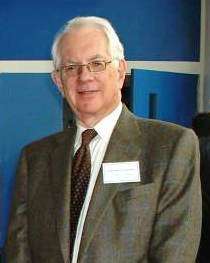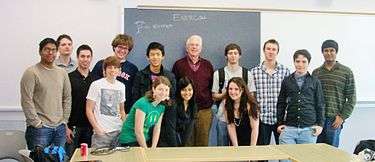Sheldon Lee Glashow
Sheldon Lee Glashow (US: /ˈɡlæʃoʊ/,[1][2] UK: /ˈɡlæʃaʊ/;[3] born December 5, 1932) is a Nobel Prize-winning American theoretical physicist. He is the Metcalf Professor of Mathematics and Physics at Boston University and Eugene Higgins Professor of Physics, Emeritus, at Harvard University, and is a member of the Board of Sponsors for the Bulletin of the Atomic Scientists.
Sheldon Lee Glashow | |
|---|---|
 | |
| Born | December 5, 1932 New York City, New York, U.S. |
| Alma mater | Cornell University (A.B., 1954) Harvard University (Ph.D., 1959) |
| Known for | Electroweak theory Georgi–Glashow model GIM mechanism Glashow resonance Chiral color Very special relativity Trinification Criticism of Superstring theory |
| Spouse(s) | Joan Shirley Alexander ( m. 1972) |
| Children | 4 |
| Awards | Nobel Prize in Physics (1979) |
| Scientific career | |
| Fields | Theoretical Physics |
| Institutions | Boston University Harvard University University of California, Berkeley |
| Thesis | The vector meson in elementary particle decays (1958) |
| Doctoral advisor | Julian Schwinger |
Birth and education
Sheldon Lee Glashow was born in New York City, to Jewish immigrants from Russia, Bella (née Rubin) and Lewis Gluchovsky, a plumber.[4] He graduated from Bronx High School of Science in 1950. Glashow was in the same graduating class as Steven Weinberg, whose own research, independent of Glashow's, would result in Glashow, Weinberg, and Abdus Salam sharing the 1979 Nobel Prize in Physics (see below).[5] Glashow received a Bachelor of Arts degree from Cornell University in 1954 and a Ph.D. degree in physics from Harvard University in 1959 under Nobel-laureate physicist Julian Schwinger. Afterwards, Glashow became a NSF fellow at NORDITA and joined the University of California, Berkeley where he was an associate professor from 1962 to 1966.[6] He joined the Harvard physics department as a professor in 1966, and was named Eugene Higgins Professor of Physics in 1979; he became emeritus in 2000. Glashow has been a visiting scientist at CERN, and professor at Aix-Marseille University, MIT, Brookhaven Laboratory, Texas A&M, the University of Houston, and Boston University.[5]
Research
In 1961, Glashow extended electroweak unification models due to Schwinger by including a short range neutral current, the Z0. The resulting symmetry structure that Glashow proposed, SU(2) × U(1), forms the basis of the accepted theory of the electroweak interactions. For this discovery, Glashow along with Steven Weinberg and Abdus Salam, was awarded the 1979 Nobel Prize in Physics.
In collaboration with James Bjorken, Glashow was the first to predict a fourth quark, the charm quark, in 1964. This was at a time when 4 leptons had been discovered but only 3 quarks proposed. The development of their work in 1970, the GIM mechanism showed that the two quark pairs: (d.s), (u,c), would largely cancel out flavor changing neutral currents, which had been observed experimentally at far lower levels than theoretically predicted on the basis of 3 quarks only. The prediction of the charm quark also removed a technical disaster for any quantum field theory with unequal numbers of quarks and leptons — an anomaly — where classical field theory symmetries fail to carry over into the quantum theory.
In 1973, Glashow and Howard Georgi proposed the first grand unified theory. They discovered how to fit the gauge forces in the standard model into an SU(5) group, and the quarks and leptons into two simple representations. Their theory qualitatively predicted the general pattern of coupling constant running, with plausible assumptions, it gave rough mass ratio values between third generation leptons and quarks, and it was the first indication that the law of Baryon number is inexact, that the proton is unstable. This work was the foundation for all future unifying work.
Glashow shared the 1977 J. Robert Oppenheimer Memorial Prize with Feza Gürsey.[7][8]
Criticism of superstring theory
Glashow is a skeptic of superstring theory due to its lack of experimentally testable predictions. He had campaigned to keep string theorists out of the Harvard physics department, though the campaign failed.[9] About ten minutes into "String's the Thing", the second episode of The Elegant Universe TV series, he describes superstring theory as a discipline distinct from physics, saying "...you may call it a tumor, if you will...".[10]

Personal life
Glashow is married to the former Joan Shirley Alexander. They have four children.[5] Lynn Margulis was Joan's sister, making Carl Sagan his former brother-in-law. Daniel Kleitman, who was another doctoral student of Julian Schwinger, is also his brother-in-law, through Joan's other sister, Sharon.
In 2003 he was one of 22 Nobel Laureates who signed the Humanist Manifesto.[11] Glashow has described himself as a "practising atheist" and he is a Democrat.[12]
Glashow is one of the 20 American recipients of the Nobel Prize in Physics to sign a letter addressed to President George W. Bush in May of 2008, urging him to "reverse the damage done to basic science research in the Fiscal Year 2008 Omnibus Appropriations Bill" by requesting additional emergency funding for the Department of Energy’s Office of Science, the National Science Foundation, and the National Institute of Standards and Technology.[13]
Works
- The charm of physics (1991) ISBN 0-88318-708-6
- From alchemy to quarks: the study of physics as a liberal art (1994) ISBN 0-534-16656-3
- Interactions: a journey through the mind of a particle physicist and the matter of this world (1988) ISBN 0-446-51315-6
- First workshop on grand unification: New England Center, University of New Hampshire, April 10–12, 1980 edited with Paul H. Frampton and Asim Yildiz (1980) ISBN 0-915692-31-7
- Third Workshop on Grand Unification, University of North Carolina, Chapel Hill, April 15–17, 1982 edited with Paul H. Frampton and Hendrik van Dam (1982) ISBN 3-7643-3105-4
- "Desperately Seeking Superstrings?" with Paul Ginsparg in Riffing on Strings: Creative Writing Inspired by String Theory (2008) ISBN 978-0-9802114-0-5
Awards and Honors
- J. Robert Oppenheimer Memorial Prize (1977)
- Nobel Prize in Physics (1979)
- Golden Plate Award of the American Academy of Achievement (1980)[14]
See also
References
Notes
- "Glashow". The American Heritage Dictionary of the English Language (5th ed.). Boston: Houghton Mifflin Harcourt. Retrieved 30 July 2019.
- "Glashow". Collins English Dictionary. HarperCollins. Retrieved 30 July 2019.
- {{Cite Oxford Dictionaries|Glashow, Sheldon Lee|accessdate=30 July 2019}}
- Sheldon Lee Glashow – Britannica Encyclopedia. Britannica.com. Retrieved on 2012-07-27.
- Glashow's autobiography. Nobelprize.org. Retrieved on 2012-07-27.
- Sheldon Glashow. Jewishvirtuallibrary.org. Retrieved on 2012-07-27.
- Walter, Claire (1982). Winners, the blue ribbon encyclopedia of awards. Facts on File Inc. p. 438. ISBN 9780871963864.
- "Gürsey and Glashow share Oppenheimer memorial". Physics Today. American Institute of Physics. 30 (5): 95. May 1977. doi:10.1063/1.3037556.
- Jim Holt (2006-10-02), "Unstrung", The New Yorker. Retrieved on 2012-07-27.
- "[T]here ain't no experiment that could be done nor is there any observation that could be made that would say, `You guys are wrong.' The theory is safe, permanently safe." He also said, "Is this a theory of Physics or Philosophy? I ask you" NOVA interview
- "Notable Signers". Humanism and Its Aspirations. American Humanist Association. Retrieved October 2, 2012.
- Sheldon Glashow, Nobel Prize in Physics for the Electroweak Theory . La Vanguardia, 20 June 2017, raed.academy/wp-content/uploads/2017/06/Sheldon-Lee-Glashow-contraLVeng.pdf.
- "A Letter from America's Physics Nobel Laureates" (PDF).
- "Golden Plate Awardees of the American Academy of Achievement". www.achievement.org. American Academy of Achievement.
External links
| Wikiquote has quotations related to: Sheldon Lee Glashow |
- Sheldon Lee Glashow at the Mathematics Genealogy Project
- Sheldon Lee Glashow on Nobelprize.org including the Nobel Lecture, December 8, 1979 Towards a Unified Theory – Threads in a Tapestry
- Sheldon Lee Glashow on www.nobel-winners.com
- Interview with Glashow on Superstrings
- Contributions to the theory of the unified weak and electromagnetic interaction between elementary particles, including inter alia the prediction of the weak neutral current.
- Sheldon Glashow Boston University Physics Department
- Sheldon Glashow Photos
- Interview with Glashow About Contemporary Physics and Winning the Nobel Prize
- Sheldon Lee Glashow on INSPIRE-HEP

- Sheldon Lee Glashow on IMDb